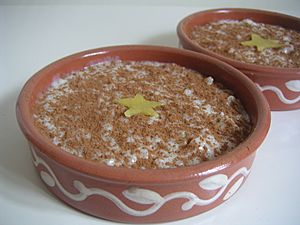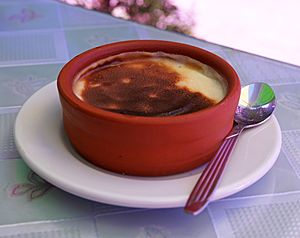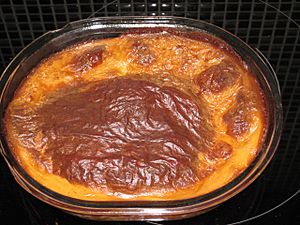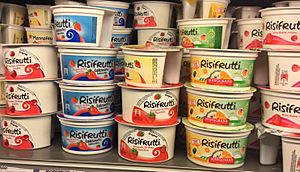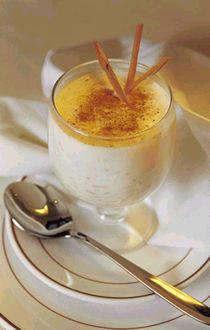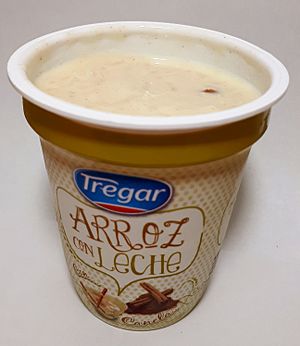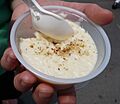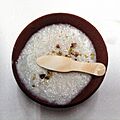Rice pudding facts for kids
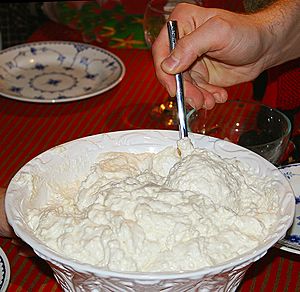
Risalamande being served during the traditional Scandinavian Christmas meal
|
|
| Alternative names | Arroz con leche, creamed rice, sütlaç, sholezard, riz au lait, arroz-doce, kheer |
|---|---|
| Type | Pudding |
| Place of origin | Worldwide |
| Serving temperature | Any temperature |
| Main ingredients | Rice, water or milk |
Rice pudding is a yummy dish made from rice mixed with water or milk. People often add other tasty things like cinnamon, vanilla, and raisins.
This dish can be a sweet dessert or a savory dinner. When it's a dessert, it usually has sugar or another sweetener. Rice puddings are popular all over the world, especially in Asia where rice is a main food. Some kinds get thick just from the rice itself. Others have eggs, making them a bit like a custard.
Contents
Exploring Rice Pudding Around the World
Rice pudding is eaten in almost every part of the world! Recipes can be very different, even in the same country. You can boil it on the stove or bake it in the oven. The way it's made and the ingredients used change how it tastes.
Here are some common ingredients you'll find in rice puddings:
- Rice: This can be white rice (short-grain, long-grain, basmati, or jasmine rice), brown rice, or even black rice.
- Milk: People use whole milk, coconut milk, cream, or evaporated milk.
- Spices: Common spices include cardamom, nutmeg, cinnamon, or ginger.
- Flavorings and toppings: Think vanilla, orange, lemon, rose water. Toppings can be pistachios, almonds, cashews, raisins, or walnuts.
- Sweeteners: These can be sugar, honey, sweetened condensed milk, dates, fruit, or different syrups.
- Eggs: Sometimes, eggs are added to make it thicker.
Rice Pudding in the Middle East and Africa
Many delicious rice puddings come from these regions.
- Moghli (Lebanese) has special spices like anise and caraway.
- Fırın sütlaç (Turkish) is baked and often has cinnamon on top.
- Sütlaç (Turkish) is served cold and sometimes browned.
- Riz bi haleeb (Levantine) means "rice with milk" and often has rosewater.
- Sholezard (Iranian) is a yellow pudding made with saffron and rose water. It's often served on special Islamic holidays.
Rice Pudding in Asia
In Southeast Asia, many sweet rice dishes are like rice pudding. They are often called sweet rice porridge.
- Ba bao fan (Chinese) is a sweet sticky rice dish with fruits and nuts. It's a tradition for Chinese New Year.
- Bubur ketan hitam (Indonesia) is a black glutinous rice porridge.
- Pulut hitam (Malaysia/Singapore) is similar to the Indonesian version.
- Kheer (Indian Subcontinent) is made with milk that is slowly boiled.
- Payasam (South Indian) is another type of Kheer.
Rice Pudding in Europe
In the United Kingdom and Ireland, rice pudding is a classic dessert. It's usually made with a special "pudding rice" which is a short-grain rice.
The first recipes for rice pudding were called whitepot and date back to the Tudor period. Traditional rice pudding uses pudding rice, milk, cream, and sugar. It can be flavored with vanilla, nutmeg, or cinnamon. You can cook it in a saucepan or bake it in the oven.
When baked, the rice, milk, cream, and sugar are mixed in a dish and cooked slowly. This makes the rice soft and the pudding creamy. Sometimes, a thick crust forms on top, which many people love! It's common to sprinkle nutmeg on top before baking.
Ready-made rice pudding in cans or pots is very common in supermarkets. A popular brand is Ambrosia.
European Variations
Many European countries have their own versions of rice pudding:
- Arroz con leche (Spanish) often has cinnamon and lemon peel.
- Arroz doce (Portuguese) is thick and soft, often decorated with cinnamon.
- Milchreis (German) is served with cinnamon, sugar, or fruit sauces like apple sauce.
- Riisipuuro (Finnish) is a Christmas dish, often served with cinnamon and sugar.
- Riz au lait (French) is a classic French version.
- Rizogalo (Greek) is cooked on the stovetop or baked, with milk, sugar, vanilla, and cinnamon.
Nordic Countries' Special Rice Pudding
In Nordic countries, rice porridge is a common breakfast or lunch. It's a warm dish made from rice cooked in milk. People usually sprinkle it with cinnamon, sugar, and a bit of butter.
This rice porridge is also the base for a cold dessert called rice cream. Cold rice porridge is mixed with whipped cream and sweetened.
- In Denmark, Risalamande is a popular Christmas dessert. It's cold rice porridge mixed with whipped cream, vanilla, and chopped almonds. It's often served with a hot or cold cherry sauce.
- In Norway, this dessert is called riskrem and is often served with a red berry sauce.
A fun Christmas tradition in Scandinavia is hiding a whole almond in the porridge. The person who finds it is said to have good luck next year, or they might win a small prize!
Rice Pudding in the Americas
In Canada and the United States, many rice pudding recipes came from European immigrants. Now, recipes from South Asia, the Middle East, and Latin America are also popular.
- In New England, a popular pudding uses long-grain rice, milk, and sugar or maple syrup. It might have nutmeg, cinnamon, or raisins.
- Arroz con dulce (Puerto Rican) is made with coconut cream, milk, spices, and raisins.
- Arroz con leche (Dominican Republic, Nicaragua, El Salvador, Costa Rica, Bolivia, Paraguay, Chile, Uruguay, Venezuela, Cuba, Panama, Argentina, Mexico, Colombia, Peru) is very popular throughout Latin America. It often includes cinnamon, raisins, and sometimes lemon or orange zest. In Argentina, it can be served with dulce de leche, chocolate, or nuts.
- Sweet rice (Trinidadian and Guyanese) uses coconut milk, nutmeg, cinnamon, and raisins.
Rice Pudding in Stories
Rice pudding has appeared in many old books and stories. It was often seen as a simple, cheap food, given to children or people who were sick. Sometimes, characters in stories would complain about having to eat it too often!
For example, in a poem by A. A. Milne, a girl named Mary Jane is crying because she has to eat "rice pudding again." This shows how common it was as a meal for kids.
Images for kids
-
Indian Kheer in a restaurant
See also
 In Spanish: Arroz con leche para niños
In Spanish: Arroz con leche para niños


